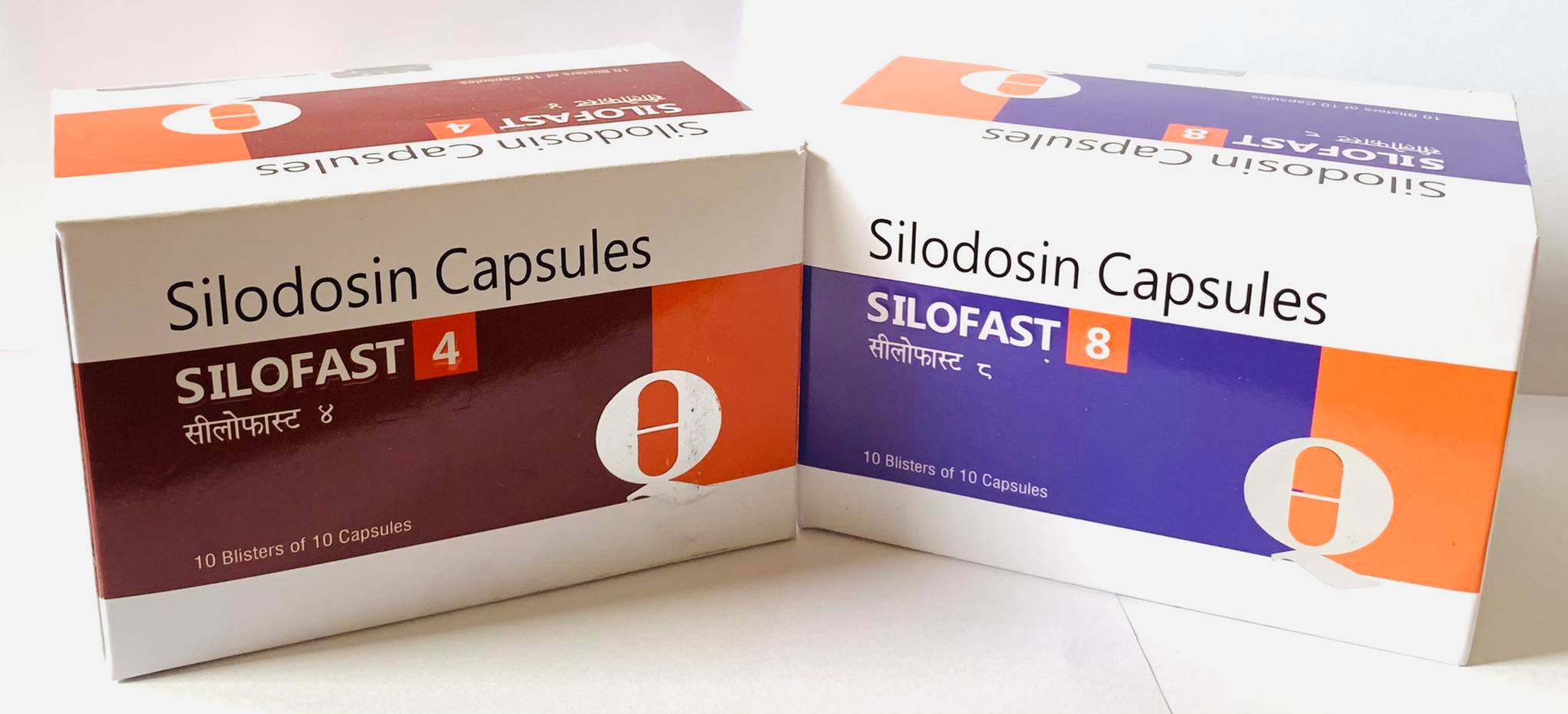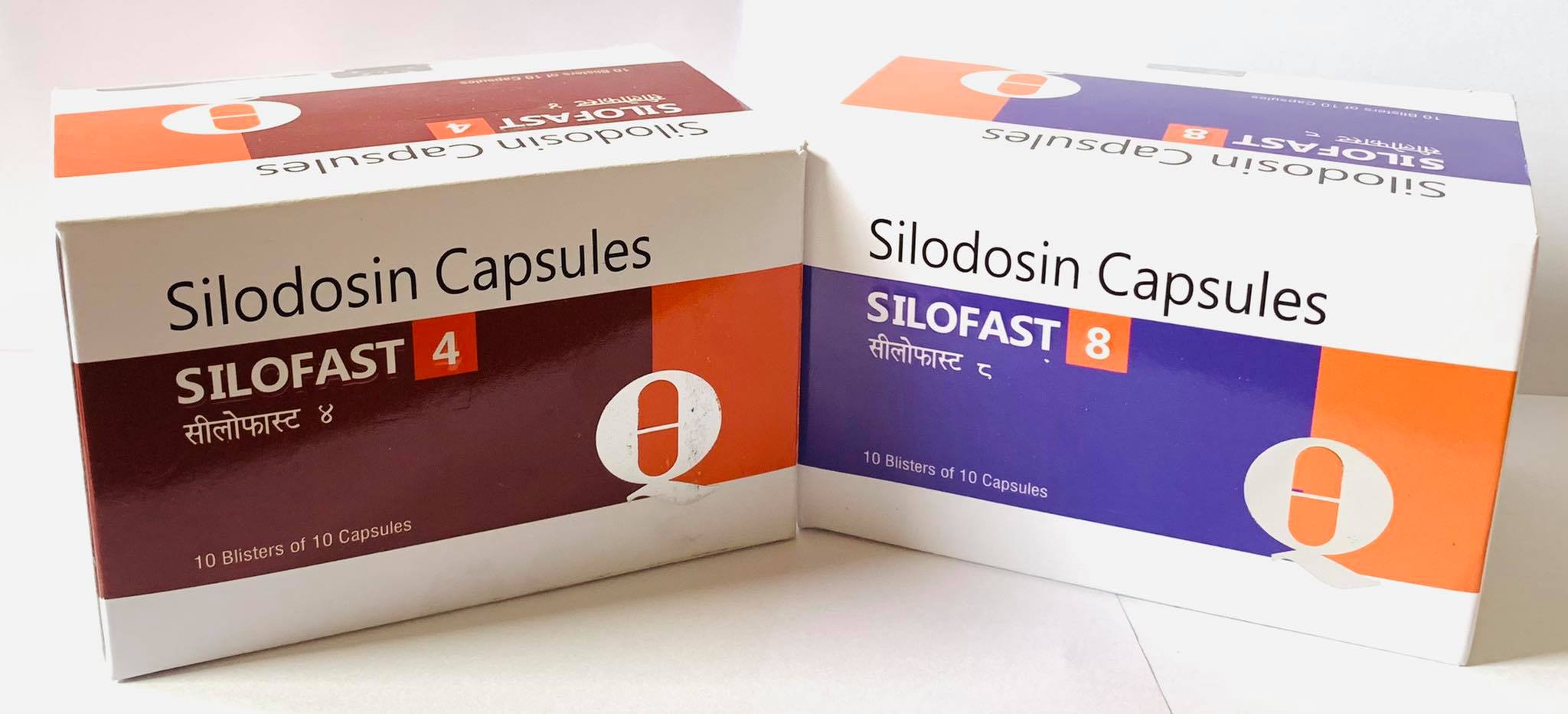



The active ingredient of SILOFAST is Silodosin, Urological, and Alpha-Adrenoreceptor antagonists.
Each Capsules Contains silodosin 4/ 8 mg.
Pack Size: 10*10 Alu/Alu.
Pharmacotherapeutic group: Urological, alpha-adrenoreceptor antagonists.
Pharmacodynamics Properties
Mechanism of Action
Silodosin is a selective antagonist of α1A-adrenoreceptors primarily located in the human prostate, bladder base, bladder neck, prostatic capsule and prostatic urethra. Data from an in vitro study showed that silodosin has lower affinity for α1B-adrenoreceptors that are primarily located in the cardiovascular system than for the α1A-adrenoreceptor subtype. Blockade of α1A-adrenoreceptors causes smooth muscle in these tissues to relax, thus decreasing bladder outlet resistance, without affecting detrusor smooth muscle contractility. This causes an improvement of both storage (irritative) and voiding (obstructive) symptoms (Lower urinary tract symptoms, LUTS) associated with Benign Prostatic Hyperplasia. Pharmacokinetics The pharmacokinetics of Silodosin and its main metabolites have been evaluated in adult male subjects with and without BPH after single and multiple administrations with doses ranging from 0.1 mg to 48 mg per day. The pharmacokinetics of Silodosin is linear throughout this dose range. The exposure to the main metabolite in plasma, Silodosin Glucuronide (KMD-3213G), at steady state is about 3-fold that of the parent substance. Silodosin and its Glucuronide reach steady-state after 3 days and 5 days of treatment, respectively.
Silodosin administered orally is well absorbed and absorption is dose proportional. The absolute bioavailability is approximately 32 %.An in vitro study with Caco-2 cells showed that Silodosin is a substrate for P-glycoprotein. Food decreases Cmax by approximately 30 %, increases tmax by approximately 1 hour and has little effect on AUC. In healthy male subjects of the target age range (n=16, mean age 55 ± 8 years) after once-a-day oral administration of 8 mg immediately after breakfast for 7 days, the following pharmacokinetic parameters were obtained: Cmax 87 ± 51 ng/ml (sd), tmax 2.5 hours (range 1.0-3.0), AUC433 ± 286 ng h/ml.
Silodosin has a volume of distribution of 0.81 l/kg and is approximately 95% bound to plasma proteins, while binding of Silodosin Glucuronide is approximately 92%. Silodosin did not distribute into blood cells under in vitro conditions.
Silodosin undergoes extensive metabolism through Glucuronidation (UGT2B7), alcohol and Aldehyde Dehydrogenase and oxidative pathways, mainly CYP3A4. The main metabolite in plasma, the glucuronide conjugate of silodosin (KMD-3213G), that has been shown to be active in vitro, has an extended half-life (approximately 24 hours) and reaches plasma concentrations approximately four times higher than those of silodosin. In vitro data indicate that silodosin does not inhibit or induce cytochrome P450 enzyme systems.
Following oral administration of 14C-labelled Silodosin, the recovery of radioactivity after 7 days was approximately 33.5 % in urine and 54.9 % in faeces. Body clearance of Silodosin was approximately 0.28 l/h/kg. Silodosin is excreted mainly as metabolites, very low amounts of unchanged drug are recovered in urine. The terminal half-life of parent drug and its Glucuronide is approximately 11 hours and 18 hours, respectively.
Silodosin is metabolized extensively, mainly via CYP3A4, alcohol Dehydrogenase and UGT2B7. Co-administration of Silodosin with agents that interfere with these enzymes may increase circulating levels of unchanged Silodosin. Silodosin is also a substrate for P-Glycoprotein and exposure may be enhanced by P-Glycoprotein inhibitors. Substances that inhibit (such as Ketoconazole, Itraconazole, Ritonavir or Cyclosporine) or induce (such as Rifampicin, Barbiturates, Carbamazepine, Phenytoin) these enzymes and transporters may affect the plasma concentrations of Silodosin and its active metabolite.
There is inadequate information about the safe use of silodosin in association with other α-Adrenoreceptor antagonists. Consequently, the concomitant use of other α-adrenoreceptor antagonists is not recommended.
In an interaction study, a 3.7-fold increase in maximum Silodosin plasma concentrations and a 3.1-fold increase in Silodosin exposure (i.e. AUC) were observed with concurrent administration of a potent CYP3A4 inhibitor (Ketoconazole 400 mg). Concomitant use with potent CYP3A4 inhibitors (such as Ketoconazole, Itraconazole, Ritonavir or Cyclosporine) is not recommended. When silodosin was co-administered with a CYP3A4 inhibitor of moderate potency such as Diltiazem, an increase in Silodosin AUC of approximately 30 % was observed, but Cmax and half-life were not affected. This change is clinically not relevant and no dose adjustment is required.
Since in vitro studies indicated that Silodosin is a P-gp substrate, inhibition of P-gp may lead to increased Silodosin concentrations. Therefore, co administration with strong P-gp inhibitors is not recommended.
Patients taking PDE-5 inhibitors concomitantly with Silodosin should be monitored for possible adverse reactions.
In the clinical study program, many patients were on concomitant Antihypertensive therapy (mostly agents acting on the Rennin-Angiotensin system, Beta-Blockers, Calcium Antagonists and Diuretics) without experiencing an increase in the incidence of Orthostatic Hypotension. Nevertheless, caution should be exercised when starting concomitant use with Anti-Hypertensive and patients should be monitored for possible adverse reactions.
Steady state levels of Digoxin, a substrate of P-Glycoprotein, were not significantly affected by co-administration with Silodosin 8 mg once daily. No dose adjustment is required.
Immune system disorders
Allergic-type reactions including Facial Swelling, Swollen Tongue and Pharyngeal Oedema.
Psychiatric disorders
Libido decreased
Nervous system disorders
Dizziness
Syncope loss of consciousness
Cardiac disorders
Tachycardia
Palpitations
Vascular disorders
Orthostatic Hypotension**
Hypotension
Respiratory, thoracic and mediastinal disorders
Nasal Congestion
Gastrointestinal disorders
Diarrhea
Nausea, Dry mouth Hepato Biliary Disorders,Abnormal Liver Function Tests
Skin and subcutaneous tissue disorders
Skin Rash, Pruritus, Urtricaria, and Drug Eruption
Reproductive system and breast disorders
Ejaculatory Disorders, including Retrograde Ejaculation, an Ejaculation
Erectile Dysfunction, Injury, poisoning and procedural complication
Intraoperative Floppy Iris Syndrome*